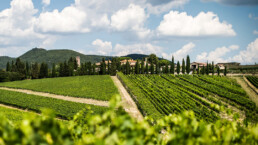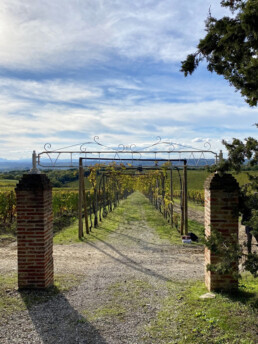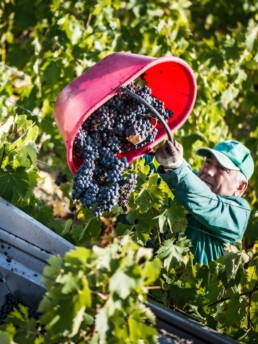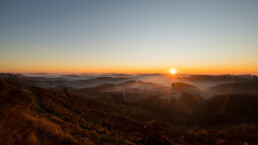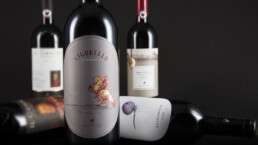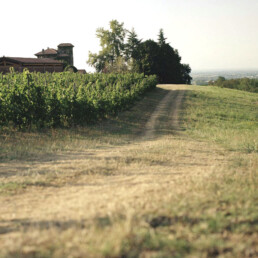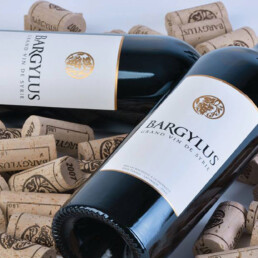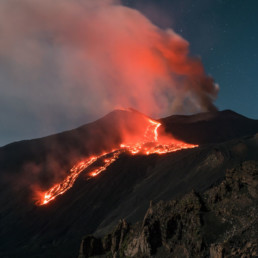San Felice: A Tuscan Treasure
A winery steeped in history and looking to the future.
There are plenty of reasons to love Italy! We all know Italy is the land of food, art, architecture, wine, fashion, and so much more. For us wine lovers in particular, Italy is a treasure trove awaiting exploration. Several of its growing regions and grape varieties are household names – and who hasn’t heard of Chianti? But for too long Chianti has gotten a bad rap, no doubt hailing back to the days of daggy straw-wrapped flasks and cheap and ‘almost cheerful’ wines. But it deserves better. Fittingly there has been a renaissance taking place. And at the forefront is our Dhall & Nash Wondermaker, Agricola San Felice. A winery in the heart of Chianti Classico, steeped in history but looking to the future…
“[ …] Chianti Classico has never been such an exciting wine as it is today.” – Jancis Robinson MW
San Felice is an outstanding Tuscan winery who have pioneered key developments in the Chianti Classico region for the last 50 years. Based in Castelnuovo Berardenga, around 45 kms south-east of Florence and at the southern end of the Chianti Classico zone, this reputable estate includes 140 hectares of vineyard, a cellar, around 17,000 olive trees, and a medieval village, Borgo San Felice, with a prestigious hotel complex. Indeed, this is a bucolic picture-perfect Tuscan wonderland.
(By the way… Call us crazy, (yes, we are! Crazy for vino Italiano!) but because Chianti has such succulent savoury flavours with high acidity and bold tannins, it just cries out for food. So, we’ve paired a few traditional Tuscan staples to each of our sections to inspire your next cook-up with a glass of San Felice Chianti Classico in hand! Buon appetito!)
The History:
(As rich as Pappardelle al Cinghiale / Tuscan Wild Boar Pasta)
San Felice takes its name from a church on the property that is found in records as far back as 714 AD and which was named after a local early Christian saint. The Grisaldi Del Taja family were owners of this land for several centuries and produced wine here over that time. Their descendants were among the founding members of the consortium of Chianti Classico (which turned 300 recently).
However, by 1967 the estate was passed on to Enzo Morganti. In this context we must remember that Chianti Classico in the 1960s hadn’t changed a whole lot for a few centuries. Land management and agricultural activities were based on the sharecropping system and, as far as wine was concerned, the focus was on quantity, not quality. That was the situation Enzo Morgante found himself in.
Despite the fact that the Sangiovese vines at San Felice were planted in wide rows interspersed with olive trees, Morgante believed in the potential of this indigenous Italian grape variety in this site. He was a purist when it came to Sangiovese and is largely responsible for the modern style of much of the Sangiovese we drink today. After spending two decades experimenting with clones of Sangiovese at Tenuta di Lilliano, this Tuscan wine pioneer took control of the famous San Felice Chianti Classico estate. Slowly but surely, he began replanting the vineyards with quality clones and managed to turn it into the national viticultural treasure it is today. Since the late ‘70s it has been owned by Allianz S.p.A Group who have continued this commitment to scientific research and quality wines.
Tradition & Innovation:
(A perfect marriage like Tagliatelle Funghi Porcini e Tartufi / Porcini Mushroom & Truffle Pasta)
On the foundation of Morgante’s work, San Felice continues to be a pioneering winery. Always at the forefront, San Felice anticipates trends and conducts a lot of research. This modernity is balanced by their respect for the uniqueness of the terroir with the traditions from this historic region. San Felice has become one of the most influential estates in Chianti Classico, and they continue to be one of the most innovative.
As a natural progression to Morgante’s deep research into his beloved Sangiovese grape, in 1968, he introduced a new wine from 100% Sangiovese called Vigorello. At that time, Chianti Classico was a blend, including white grapes; a pure Sangiovese wasn’t sanctioned by the DOC regulations (Chianti Classico officially became a subzone of Chianti in 1967). Despite the fact that Vigorello was labelled as a Vino da Tavola (table wine), the lowest denomination, it was the winery’s most expensive wine. In fact, Vigorello was the very first Super Tuscan from the Chianti Classico area. The more internationally acclaimed Tignanello by Antinori would debut in 1971. Vigorello, started out as all Sangiovese, however, it evolved to include some Merlot, Cabernet Sauvignon and Petit Verdot similar to its more famous Super Tuscan rivals.
Despite the initial reliance on French grape varieties for its Super Tuscan, Vigorello, now it has the Pugnitello grape as a major component in the blend. This came about when San Felice planted over 270 traditional Tuscan grape varieties in a 5-acre experimental plot, the Vitiarium. This has been an invaluable long-term research programme conducted in conjunction with the Universities of Florence and Pisa. In this experimental vineyard the DNA of forgotten native Tuscan vines are stored and mapped. The study and analysis of genetic heritages has made it possible to identify 30 varieties and to aim for the rediscovery of some vines, including for example Pugnitello.
This ancient, almost-extinct grape is super interesting in that the bunches grow in small round clusters shaped like a fist. Fist is ‘Pugno’ in Italian. It has since been planted to 30 acres on the San Felice estate, second only to Sangiovese in terms of acreage there. It has shown enough promise that San Felice makes it as a solo bottling, and also has introduced it into the Vigorello blend as the majority grape with the 2011 vintage, to infuse a more Tuscan character.
Wine Enthusiast selected San Felice among the Top 5 finalists for “2016 European Winery of the Year”, the only Italian winery among all categories.
Adding to their innovative quest, In the 1970’s, San Felice introduced Poggio Rosso which was a first example of a Chianti Classico ‘Cru’. They were also amongst the first Chianti Classico estates to produce a ‘Gran Selezione’ wine – a new classification introduced as the top-quality tier for wines in the region – with the inaugural 2010 vintage.
The innovative capacity and the desire to improve of San Felice never stops. In 1982 the company expanded further with the purchase of the Campogiovanni Estate, 20 hectares on the hills of Montalcino for the production of Brunello. Today the properties are spread over 250 hectares of vineyards in 4 estates: San Felice in Castelnuovo Berardenga, in the heart of the Chianti Classico, Campogiovanni in Montalcino, Perolla in the Tuscan Maremma and the recent acquisition of the Bell’Aja estate in Bolgheri.
Terroir:
(As earthy as Crostini di Fegatini / Croutons with Chicken Livers)
The San Felice Chianti Classico estate is at an altitude of about 400 metres above sea level. The perfect combination of soil and micro-climate, together with the wide temperature range, creates the ideal conditions for producing truly exceptional wines. To accentuate the distinctive characteristics of each vineyard, they were divided into different zones in the 1990s. They identified five macro-areas and planted the grape varieties best-suited to the soil and geography of each. Amazingly, they have 61 vineyards planted with 22 Sangiovese clones. The vineyards lie in the gently rolling hills where the vines benefit from two distinct soils: calcareous clay, which produces long-aging reds with excellent structure, and a combination of sand and lime that gives younger wines, both red and white, great freshness and texture.
More specifically, for the single vineyard sites the soils are quite distinctive. The Poggio Rosso and Vigorello sites’ soils are: medium textured, predominantly calcareous marl breakdown of alberese (hard white marl) and galestro (a schistous, friable clay) strata, with abundant gravel-pebble mixture. There are also some fingers extending into silt- and sand-rich alluvial soils.
“Its new wines from the top of the appellation’s quality pyramid are very impressive and could mark a new chapter for this celebrated Tuscan estate” – Robert Parker’s Wine Advocate
The San Felice Wines:
(Perfectly paired with Bistecca alla Fiorentina / Florentine T-Bone Steak)
Winemaker Leonardo Bellaccini crafts a portfolio of wines which is highly regarded and multi award-winning – they are classic expressions of high-quality Sangiovese. Dhall & Nash are honoured to have these as part of our prestigious European line-up…
2018 San Felice Chianti Classico DOCG:
“This is bright and vivid, showing blueberries, blackberries with violets and other flowers. Medium to full body, tight tannins, bright acidity, and a vivid finish. Real Chianti Classico.” 92/100 points. James Suckling
“Aromas of violet, black-skinned fruit and underbrush aromas form the nose. Juicy and polished, the savoury accessible palate delivers succulent Marasca cherry, clove, and a hint of star anise alongside lithe tannins. Bright acidity keeps it tangy and balanced. Drink through 2025.” 91/100 points. Wine Enthusiast
“Pure fruit flavours of black cherry and black currant are accented by floral, tar, and iron. It’s dense and powerful, with a long, well-integrated finish. Best from 2022 through 2035.” 90/100 points. Wine Spectator
2016 San Felice Poggio Rosso Chianti Classico ‘Gran Selezione’ DOCG:
“From a parcel originally planted in the 1970s with selected Sangiovese clones. Appropriately developing in its aroma profile, this doles out tobacco, bay leaf, leather, dried thyme, and a suggestion of chestnut. The palate is bright with sour cherry, tart redcurrant, and a kick of tangy acidity. The tannins are compact and dense – still quite chewy, this could do with another year or so in the cellar.” 92/100 points. Decanter
2015 San Felice Vigorello (Toscana IGT):
“A blend of 35% Pugnitello, 30% Merlot, 30% Cabernet Sauvignon and 5% Petit Verdot, the 2015 Vigorello seems to have the concept of vigour and strength at its very core. The wine opens to an inky dark appearance, with thick layers of dark fruit, spice, cured leather, camphor, and campfire ash. You feel the sweet ripeness of the warm vintage in the soft and succulent quality of the background structure.” 94/100 points. Robert Parker’s Wine Advocate
In the 2021 Gambero Rosso Italian Wine Guide, San Felice Chianti Classico DOCG ’18 is awarded the “top step of the podium”
San Felice’s Social Project:
(Restoring the heart, mind and soul like Pasta e Fagioli / Pasta & Beans)
San Felice not only has been a trailblazer in recovering and mapping Chianti’s ancient grape growing legacy, but it has also created a retreat for youth from underprivileged backgrounds or with disabilities to meet Allianz volunteers to work together and discover new skills to help them flourish in the outside world.
These philanthropic activities that are carried out in San Felice have a special meaning as explained by Mario Cuccia from San Felice: “Our giving is like returning to the land that which has been received by its people – talented or simple, fortunate or suffering, young or old – and we want to talk to and cooperate with all of them”.
The ‘Umana Mente’ (Human Mind) Foundation began in 2001 as the main expression of social responsibility of the Allianz Group with the aim of helping the people most in difficulty and to strengthen the most vulnerable communities of our society. As part of ‘Umana Mente’ Allianz has opened their doors at their 5-star hotel, Borgo San Felice, to make the place available to everyone. “For children and people with disabilities to be welcomed into a beautiful place gives the message that they are important and valuable,” says Nicola Corti General Secretary of the Foundation.
With this in mind Borgo San Felice and Agricola San Felice have become places of genuine social inclusion where disadvantaged children and teenagers, people with disabilities, Allianz volunteers, employees, and the clients of the hotel experience life as viticulturists, agriculturalists, artists, chefs, photographers, maître d’hôtel, waiters and more. These are all new experiences that helps to develop creativity and increase the level of integration within the larger community.
Wine Geek Talk - Italian Wine Classifications:
(A bit dry like Pane Toscano / Unsalted Tuscan Bread)
Chianti is a centuries-old wine region, with the first written mention of Sangiovese dating as far back as 1398 (and wine production dating back maybe 2000 years). The region was a world first to get appellation status in 1716 from Cosimo III de Medici – yes, those Medicis! And in 1984, Chianti Classico got its DOCG. As with wines from other regions, like Bordeaux or Burgundy, Chianti Classicos have to meet certain standards, and can be classified differently.
So, as we dive into the divine depths of our San Felice wines, let’s navigate the Italian classifications to help us to recognize what’s in the bottle.
Starting from the bottom of the quality pyramid we have Table wine (Vino da Tavola), then IGT (sometimes you’ll see this as IGP, the EU standard), followed by DOC (Denominazione di Origine Controllata, or controlled designation of origin) and topped by DOCG (Denominazione di Origine Controllata e Garantita or controlled and guaranteed designation of origin).
DOC and DOCG are two quality classifications, roughly equivalent to the French AC and AOC if you’re familiar with that. These regulations, set out by each area’s consortium, indicate what is permitted in terms of production area, wine colour, grape varieties and max/min proportions, styles of wine, max/min alcohol levels as well as permitted or mandated viticultural, vinification and maturation techniques. The difference between the two is that DOCG is more restrictive than DOC; DOCG labelled wines are analysed and tasted by government–licensed staff before being bottled.
DOCG wines may have additional classifications that can tell you even more about them. These are:
– Classico: This is reserved for wines produced in the region where a particular type of wine has been produced “traditionally” with an 80% minimum of Sangiovese. For Chianti Classico, this “traditional region” is defined by a decree from July 10, 1932 and refers to a smaller subzone – as an original part of the larger Chianti region. They are aged for a minimum of 12 months before release.
– Riserva: This applies to wines with a longer ageing period of 24 months with wines demonstrating more structure and depth.
– Gran Selezione: In 2014, the denomination included an additional quality level beyond Riserva – this is the Chianti Classico Gran Selezione which requires that grapes must only be grown by the winery itself and indicates a minimum aging requirement of 30 months, including 3 months of bottle aging.
What about that “Black Rooster”? The heart of Chianti Classico is the zone that can legally use the exclusive “Gallo Nero” or black rooster label on the neck of the bottle comprises the municipalities of Greve in Chianti, Radda in Chianti, Castellina in Chianti and Gaiole in Chianti and part of the administrative area of San Casciano in Val di Pesa, Tavarnelle Val di Pesa e Barberino Val d’Elsa, Poggibonsi, and Castelnuovo Berardenga.
And what about those “Super Tuscans” you ask? In the 1970s, Tuscan wine producers began to experiment with foreign grape varietals, such as Cabernet Sauvignon, Cabernet Franc, Merlot and Syrah. By combining these with the Sangiovese grape, they created Super Tuscan wines, an unofficial category of Tuscan wines that is not recognized within the Italian wine classification system. Some of the most famous labels are: Vigorello, Tignanello, Sassicaia and Ornellaia. These high-quality wines that are marked simply as “IGT” on the quality scale have nonetheless conquered international markets due to their overwhelming vinous merit telling you that being a DOC or DOCG is not the only indication of quality.
Agricola San Felice has consistently sought excellence with its wine, by blending tradition and innovation. These wines are born of passion, experience, and the uniqueness of the terroir in which they are produced. It is this combination that provides and guarantees consistent quality and enjoyably characterful wines. San Felice wines are as essential at your dining table as a knife and fork. Cin! Cin!
